
Cute crafting activity to do with pre-k through 2nd grade. Students are able to create their own turtle shells out of recyclable materials.
- Subject:
- Environmental Science
- Life Science
- Material Type:
- Interactive
- Lesson Plan
- Date Added:
- 03/29/2024

Cute crafting activity to do with pre-k through 2nd grade. Students are able to create their own turtle shells out of recyclable materials.
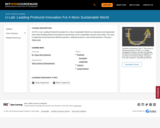
15.975 U-Lab: Leading Profound Innovation for a More Sustainable World is an interactive and experiential class about leading profound innovation for pioneering a more sustainable economy and society. The class is organized around personal reflection practices, relational practices, and societal practices. It focuses on the intertwined relationship between the evolution of capitalism, multi-stakeholder innovation, and presencing.

This website has video clips, maps, and images of the U.S. Antartartic areas. There are 3 live webcams of the current U.S. antarctic stations, various video clips, podcasts, maps and images of Antarctica.
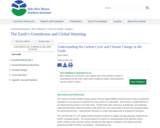
This unit will help 4th or 5th grade teachers prepare students to explore two big questions related to the Earth’s changing climate. The primary goal is to nurture an understanding of the element carbon, Earth’s carbon cycle, and how carbon dioxide and other gases contribute to the planet warming greenhouse effect of Earth’s atmosphere. The questions are:
1) What is carbon and why are all living things on Earth considered to be carbon-based lifeforms?
2) What is the greenhouse effect and why should we care about how much carbon is in our atmosphere?
These questions align with the Next Generation Science Standards (NGSS) for 4th grade that many states have adopted or adapted.1 An annotated list of the applicable NGSS and state science standards can be found in the appendix of this curriculum unit.
Under the NGSS, 4th grade students study concepts related to energy and learn that all fuels used to meet our continuously growing energy demand are derived from natural resources. Consequently, the production and usage of some energy resources adds more carbon dioxide to Earth’s atmosphere. Students are just beginning to develop an understanding of how human activities can impact the Earth and result in either positive or negative consequences.
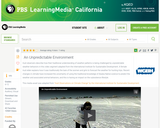
In this video segment adapted from the International Institute for Sustainable Development, Inuit observers describe how their traditional understanding of weather patterns is being challenged by unpredictable weather behaviors.
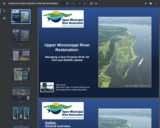
General overview:
• Human alterations to the River ecosystem
• Events that set groundwork for authorization of UMRR
Examples of HREP Design and Features:
• Island Restoration
• Dredging
• Mechanical
• Hydraulic
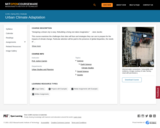
"Designing a dream city is easy. Rebuilding a living one takes imagination.†" " " -Jane Jacobs This course examines the challenges that cities will face and strategies they can use to prepare for the impacts of climate change. Particular attention will be paid to the presence of global disparities, the needs of vulnerable populations and resource constrained locales, and the ways in which local government and community-based activities can achieve equitable levels of climate-readiness.
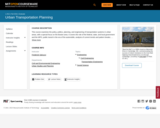
This course examines the policy, politics, planning, and engineering of transportation systems in urban areas, with a special focus on the Boston area. It covers the role of the federal, state, and local government and the MPO, public transit in the era of the automobile, analysis of current trends and pattern breaks; analytical tools for transportation planning, traffic engineering, and policy analysis; the contribution of transportation to air pollution, social costs, and climate change; land use and transportation interactions, and more. Transportation sustainability is a central theme throughout the course, as well as consideration of if and how it is possible to resolve the tension between the three E’s (environment, economy, and equity). The goal of this course is to elicit discussion, stimulate independent thinking, and encourage students to understand and challenge the "conventional wisdom†of transportation planning.
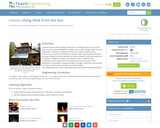
In this lesson, students will first discuss where energy comes from, including sources such as fossil fuels, nuclear, and such renewable technologies as solar. After this initial exploration, students will investigate the three main types of heat transfer: convection, conduction, and radiation. Students will learn how properties describe the ways different materials behave, for instance whether they are insulators or conductors. Students will complete a crossword puzzle to reinforce their vocabulary in this content area. The class will then focus on the acquisition and storage of energy through the design, construction, and testing of a fully functional solar oven.
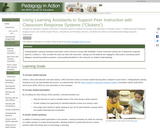
Learning Assistants are used to facilitate student discussion in peer instruction during clicker questions (i.e., classroom response systems), by asking Socratic questions, emphasizing reasoning, and probing student thinking.

This activity is a field investigation in which students conduct a plant survey of two study plots, analyze their findings through graphing and mathematic models, investigate the impact of human activity in the general area (optional) and generate questions for further investigation of the study plots.
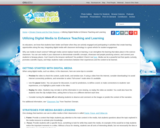
This article provides tips and strategies for effectively integrating digital media into classroom instruction. Resources provided are suitable for preschool and elementary students.
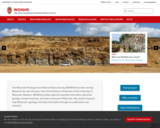
The Wisconsin Geological and Natural History Survey (WGNHS) has been serving Wisconsin for over 125 years. Part of the Division of Extension at the University of Wisconsin–Madison, WGNHS provides objective scientific information about the geology, mineral resources, and water resources of Wisconsin. We conduct research, map Wisconsin’s geology, and share information through our publications and outreach.
WGNHS has been producing geologic maps, scientific reports, and more for over 125 years. Our publications catalog offers thousands of maps, reports, datasets, and other publications—all of which are available to view and download for free.
The Wisconsin Geological and Natural History Survey (WGNHS) was created by the Wisconsin Legislature in 1897. It is the descendant of earlier state surveys in Wisconsin, which date back to 1854.
WGNHS, part of the Division of Extension at the University of Wisconsin–Madison, is an interdisciplinary organization that conducts natural resources surveys and research to produce information used for decision-making, problem-solving, planning, management, development, and education. Survey is defined to include resource inventory as well as basic and applied research and analysis. WGNHS has no specific regulatory or enforcement responsibilities.
Mission of WGNHS:
Understanding the earth • Charting its history • Sustaining its resources
The Survey conducts earth-science surveys, field studies, and research.
We provide objective scientific information about the geology, water resources, and mineral resources of Wisconsin.
We collect, interpret, disseminate, and archive natural resource information.
We communicate the results of our activities through publications, technical talks, our website, social media, and responses to inquiries from the public.
These activities support informed decision making by government, industry, business, and individual residents of Wisconsin.
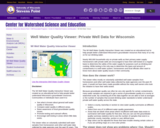
The WI Well Water Quality Interactive Viewer was created as an educational tool to help people better understand Wisconsin's groundwater resources. Communities or individuals have used it to:
See what is known about general well water quality in Wisconsin.
Compare water quality in different areas.
Raise awareness of local groundwater quality issues.
Promote testing and outreach efforts.
Encourage well testing in areas where little data exists.
The viewer relies on voluntarily submitted well water samples from homeowners and other well water data collected by state agencies over the past 25 years. This includes private well water quality data from the Center for Watershed Science and Education, the WI Dept. of Ag, Trade and Consumer Protection, and the WI Department of Natural Resources Groundwater Retrieval Network, Eau Claire County Health Dept and La Crosse County Health Dept.
The WI Well Water Viewer does not represent well water quality information for all known private wells. This information is not intended to be a substitute for well water testing and the viewer does not provide site specific information for an individual well or property. The Center for Watershed Science and Education is not responsible for misuse or misinterpretation of the data.
The compilation of data was assisted by a grant through the Environmental Public Health Tracking Program through the WI Department of Health Services.

Using three-dimensional scaffolds, these materials address the following topics: - Interactions among living species.- 10% rule and carrying capacity.- Ecosystem disruptions, including climate change. - Sustainability. Each packet is broken into five parts - data dive, core ideas, investigations, asssessments, and life connections. Formative assessments and checkpoints are embedded throughout each packet. The final packet prepares students for a summative assessment, with a provided practice assessment.Implementation instructions are embedded for each component of each packet. PDFs are included as attachments (in case the file formats are altered by this system).

Wake is a science game that challenges students with engaging and authentic missions in a variety of ocean-based ecosystems, designed to target the NGSS science practices of experimentation, modeling, and argumentation, in the context of middle school life sciences.
In the game, students take the role of a scientist studying ocean ecosystems, traveling to different ocean research sites to answer questions and solve problems. Students play the game at their own pace, working individually, and taking on gradually more complex science challenges in an open-ended environment.
Check out the Teacher Support Site for curriculum ideas and resources: https://sites.google.com/wisc.edu/waketeacherguide/home
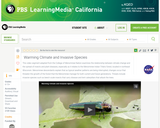
In this video segment adapted from the College of Menominee Nation, learn about the emergence of invasive forest species and diseases and their possible impact on the Menominee tribal forest.
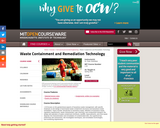
Focuses on the geotechnical aspects of hazardous waste management, with specific emphasis on the design of land-based waste containment structures and hazardous waste remediation. Introduction to hazardous waste; definition of hazardous waste, regulatory requirements, waste characteristics, geo-chemistry, and contaminant transport. The design and operation of waste containment structures, landfills, impoundments, and mine-waste disposal. The characterization and remediation of contaminated sites, the superfund law, preliminary site assessment, site investigation techniques, and remediation technologies. Monitoring requirements.
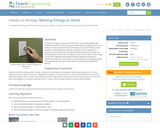
People use energy in all aspects of their lives for cooking, lighting and entertainment. Much of this energy use takes place in buildings, such as our homes. To save money and reduce the impact on our environment, many people are reducing their energy use. One way is to hire engineers to perform home energy audits to understand the ways we use energy and identify ways we can conserve energy. In this activity, students act as energy conservation engineers and identify the ways energy is conserved or wasted. They also learn many ways to personally conserve energy everyday.
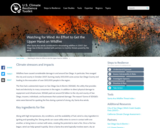
Climate scientists project that future climate conditions will result in increased risk of wildfire across much of the Southwest. Although fires are a natural part of Southern California landscapes, efforts by SDG&E and their partners may help minimize the impacts of future fires.